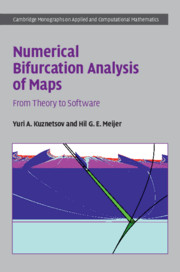3653 results in ebooks in fluid mechanics
3 - Two-Parameter Local Bifurcations of Maps
- from Part One - Theory
-
- Book:
- Numerical Bifurcation Analysis of Maps
- Published online:
- 15 March 2019
- Print publication:
- 28 March 2019, pp 50-184
-
- Chapter
- Export citation
Part Three - APPLICATIONS
-
- Book:
- Numerical Bifurcation Analysis of Maps
- Published online:
- 15 March 2019
- Print publication:
- 28 March 2019, pp 319-320
-
- Chapter
- Export citation
References
-
- Book:
- Numerical Bifurcation Analysis of Maps
- Published online:
- 15 March 2019
- Print publication:
- 28 March 2019, pp 389-399
-
- Chapter
- Export citation
5 - Numerical Methods and Algorithms
- from Part Two - Software
-
- Book:
- Numerical Bifurcation Analysis of Maps
- Published online:
- 15 March 2019
- Print publication:
- 28 March 2019, pp 219-242
-
- Chapter
- Export citation
4 - Center Manifold Reduction for Local Bifurcations
- from Part One - Theory
-
- Book:
- Numerical Bifurcation Analysis of Maps
- Published online:
- 15 March 2019
- Print publication:
- 28 March 2019, pp 185-216
-
- Chapter
- Export citation
Part One - Theory
-
- Book:
- Numerical Bifurcation Analysis of Maps
- Published online:
- 15 March 2019
- Print publication:
- 28 March 2019, pp 1-2
-
- Chapter
- Export citation
10 - Duopoly Model of Kopel
- from Part Three - APPLICATIONS
-
- Book:
- Numerical Bifurcation Analysis of Maps
- Published online:
- 15 March 2019
- Print publication:
- 28 March 2019, pp 362-384
-
- Chapter
- Export citation
6 - Features and Functionality of MATCONTM
- from Part Two - Software
-
- Book:
- Numerical Bifurcation Analysis of Maps
- Published online:
- 15 March 2019
- Print publication:
- 28 March 2019, pp 243-257
-
- Chapter
- Export citation
Part Two - Software
-
- Book:
- Numerical Bifurcation Analysis of Maps
- Published online:
- 15 March 2019
- Print publication:
- 28 March 2019, pp 217-218
-
- Chapter
- Export citation
Preface
-
- Book:
- Numerical Bifurcation Analysis of Maps
- Published online:
- 15 March 2019
- Print publication:
- 28 March 2019, pp xi-xiv
-
- Chapter
- Export citation
1 - Analytical Methods
- from Part One - Theory
-
- Book:
- Numerical Bifurcation Analysis of Maps
- Published online:
- 15 March 2019
- Print publication:
- 28 March 2019, pp 3-29
-
- Chapter
-
- You have access
- Export citation
Frontmatter
-
- Book:
- Numerical Bifurcation Analysis of Maps
- Published online:
- 15 March 2019
- Print publication:
- 28 March 2019, pp i-iv
-
- Chapter
- Export citation
11 - The SEIR Epidemic Model
- from Part Three - APPLICATIONS
-
- Book:
- Numerical Bifurcation Analysis of Maps
- Published online:
- 15 March 2019
- Print publication:
- 28 March 2019, pp 385-388
-
- Chapter
- Export citation
Dedication
-
- Book:
- Numerical Bifurcation Analysis of Maps
- Published online:
- 15 March 2019
- Print publication:
- 28 March 2019, pp v-vi
-
- Chapter
- Export citation
7 - MATCONTM Tutorials
- from Part Two - Software
-
- Book:
- Numerical Bifurcation Analysis of Maps
- Published online:
- 15 March 2019
- Print publication:
- 28 March 2019, pp 258-318
-
- Chapter
- Export citation
2 - One-Parameter Bifurcations of Maps
- from Part One - Theory
-
- Book:
- Numerical Bifurcation Analysis of Maps
- Published online:
- 15 March 2019
- Print publication:
- 28 March 2019, pp 30-49
-
- Chapter
- Export citation
Index
-
- Book:
- Numerical Bifurcation Analysis of Maps
- Published online:
- 15 March 2019
- Print publication:
- 28 March 2019, pp 400-408
-
- Chapter
- Export citation
8 - The Generalized Hénon Map
- from Part Three - APPLICATIONS
-
- Book:
- Numerical Bifurcation Analysis of Maps
- Published online:
- 15 March 2019
- Print publication:
- 28 March 2019, pp 321-353
-
- Chapter
- Export citation
9 - Adaptive Control Map
- from Part Three - APPLICATIONS
-
- Book:
- Numerical Bifurcation Analysis of Maps
- Published online:
- 15 March 2019
- Print publication:
- 28 March 2019, pp 354-361
-
- Chapter
- Export citation

Numerical Bifurcation Analysis of Maps
- From Theory to Software
-
- Published online:
- 15 March 2019
- Print publication:
- 28 March 2019
